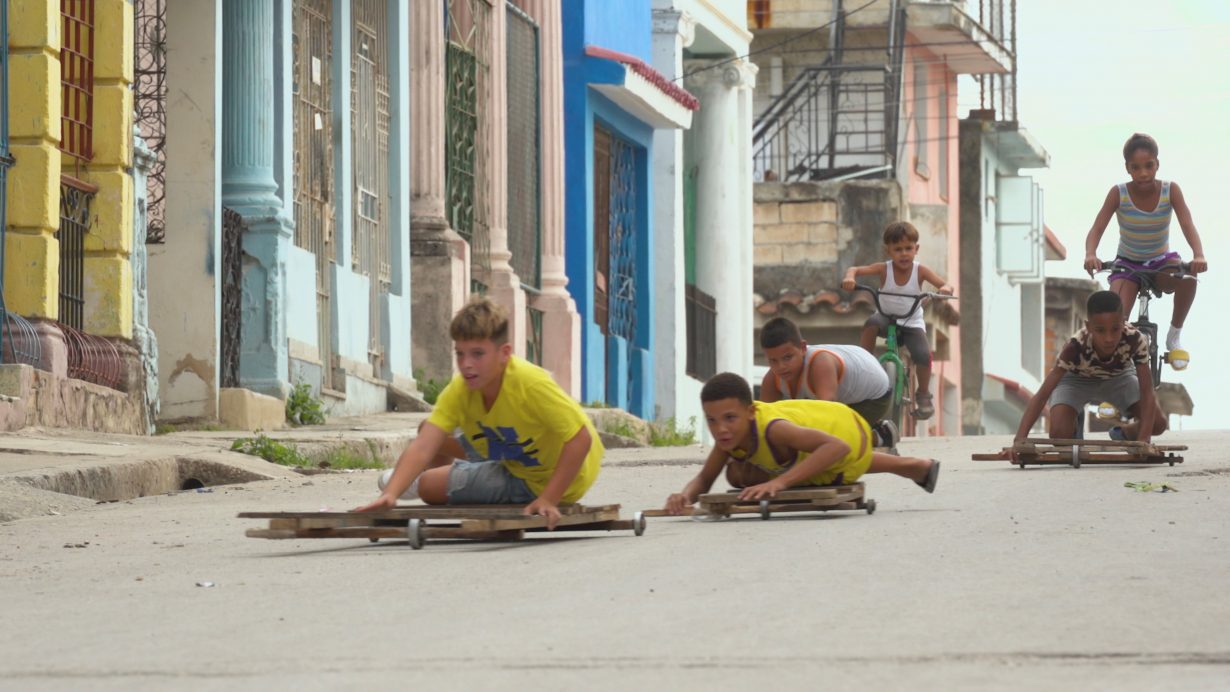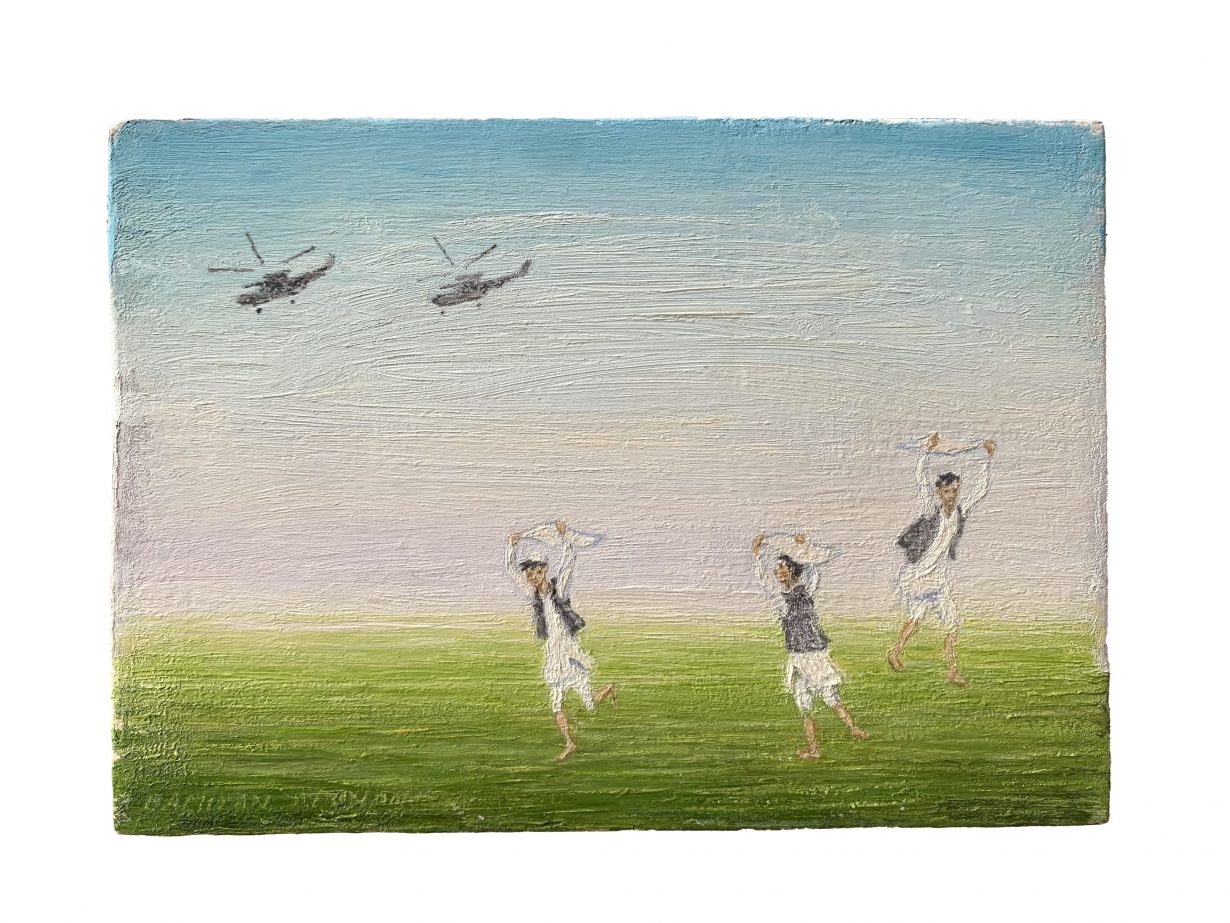From Kharkiv to Cuba, the artist’s Ricochets at London’s Barbican Centre asks: what are the kids up to?
The first screen is the largest. A girl aged about eight spins on the spot, somewhere in the Democratic Republic of Congo. The white cartoon fox on the front of her T-shirt blurs in motion. She places her rainbow-coloured clogs expertly on the golden sand as she steps in and out of the shadows of her companions, who are also spinning. She knows she’s being filmed – a self-conscious smile occasionally appears on her face – but she’s fully absorbed as she works to maintain momentum, her arms flung out to steady herself, her burgundy skirt flaring into a circle. One of her friends collapses onto the floor, overcome with dizziness. The camera pans to the earth. The video ends, the screen turns black. And then the spinning begins again. A game that derives its joy from the fact you don’t need anything but your own body to play it is a fitting opener to Ricochets, Francis Alÿs’s exploration of how children improvise, creating worlds with whatever they have to hand in their environment.
Alÿs was born in 1959 in Belgium, where as a child, the exhibition guide tells us, he saw Pieter Bruegel the Elder’s riotous Children’s Games (1560), an image that has served as a continual reference point for him since then. Alÿs moved to Mexico in 1986 and began his Children’s Games videoseries in 1999. It is now exhibited at the Barbican – the first time it has been shown in the UK – with its new title, Ricochets. Screens hung throughout the space show 40 films shot in over 15 countries, many of which are sites of geopolitical conflict, capturing a variety of games: musical chairs, leapfrog, hopscotch and their many iterations. All are activities through which children order and control their environments, and process thoughts and feelings, including those too difficult to access other than through fantasy – in peacetime and war. Each game is loosely explained in the guide: many are instantly recognisable from the playground; others are engaging because their rules can’t be immediately worked out, and thus require you to observe, follow their patterns and gradually pick them up. These stages of recognition will likely vary for every visitor. So will the emotions provoked in response to the familiar games, dependent on early memories of either being included or left out. Low black leather stools on wheels are provided so you can slide smoothly across the grey carpet between each screen. No doubt the curators hope that younger attendees will put them to other, more imaginative uses.

Social power dynamics, the commercialisation of public space and the erosion of civic community are Alÿs’s artistic preoccupations. All are present in Ricochets, which, in its design, attempts to push back against these processes. The sound of tens of films playing at once makes the Barbican’s Art Gallery cacophonous, pleasantly so. There is shrieking and laughing, of course. But also the metal wheels of haphazardly assembled chivichanas thundering over unfinished concrete in Cuba; pebbles clacking together as they are passed from hand to hand in Morocco, before they slap against the sea’s surface two or three times and then sink; the squeaky crunch of powdery snow as it is compacted under the run of a sledge in Switzerland. A large proportion of the games shown as part of Ricochets take place in conflict zones, places that crystalise Alys’s interests in power and agency. In wartime settings, children are powerless, but because ordinary routines have been disrupted, perversely they are left freer to play. In Kharkiv, Ukraine, three boys dressed in combat fatigues and armed with rifles fashioned out of planks of wood flag down mud-splattered cars and check drivers’ papers, searching for Russian spies. Most laugh and comply, although those who refuse are still saluted respectfully as they speed on. The exhibition also has a local aspect. Children from St Luke’s Primary School near the Barbican play 1, 2, 3, Freeze! with intense concentration, surrounded by thick London plane trees and, on the edges of the green, a bank of foamy cow parsley that has just come out for spring. Alÿs is an extraordinarily attentive observer, able to evoke places’ particularities with impressionistic detail, while also tracking the ways that politics permeate even seemingly spontaneous activities.


As well as play, Ricochets lays out the process by which Alys adapts to each new environment, and how the camera mediates his encounters with the children he meets there. Where you might expect wall text or captions, there are oil paintings on canvases, backlit and only a little bigger than a postcard. From afar they look like miniature screens; up close, the effect is like viewing a photographic slide using a lightbox and magnifier. Unlike the films, in which the focus is close and intimate – the camera trained on the practised, dexterous movement of hands and feet flicking marbles or kicking balls – in Alÿs’s paintings, anonymous children are dwarfed by pared back and flatly rendered structures such as billboards, walls and fences, which suggest the political settings perhaps only present by inference in the videos. For the most part, however, the background we get is limited, as few of the films and paintings correspond. In one painting, bearing the inscription ‘Yazd, Iran, 2006’ in its lefthand corner, two people ride a motorbike along the perimeter of a high cinderblock wall. There is no film from Iran shown in the exhibition. The paintings therefore only make a rather general point – that there is always some kind of political context in which children play – rather than serving to deepen our understanding of exactly what the children are up to in the accompanying films.


The arrangement of screen and canvas also hints at the improvisation behind Alÿs’s process. When he arrives at a new place, he said in a Barbican Q+A, he settles in by sketching it. While he draws, people come closer to look, peer over his shoulders. Once he’s made contact, he can ask what games are played locally; these random encounters often lead him in the right direction for his videos. The dialogue between drawing, painting and photography continues upstairs where, in darkened side rooms, line-drawing animations of hand games such as thumb wars, stacking and shadow puppets are projected on the wall in circles and squares. As with the paintings, these animations are small, less than a metre across. The hands move in the dark as if seen through a viewfinder. In two playrooms, created for visiting children with Alÿs’s long-term collaborator Rafael Ortega, Alÿs hands over the tools of his artistic practice – light, shadow, sound, scale. In the first, a brilliant-white rectangle of light is projected onto one wall, waiting for people to cast dark shadows. Elsewhere, the banister of the upper gallery is lined with a history of children’s games. We learn, for example, that ‘Blind man’s buff’ was called ‘Copper mosquito’ in Ancient Greece, and is now called ‘Blind hen’ in Spain and ‘Can you find the person who knocked you on the head?’ in Igbo communities in Nigeria. But the white laminate panels – one of which shows a shrunken reproduction of Bruegel’s Children’s Games – look a little cheap in comparison to the rich, saturated screens below. Because of the banister, they are also located, somewhat awkwardly, at child height, although the text is not written for, nor likely to be of interest to, those of primary school age. It all feels a bit redundant, anyway. Ricochets is most compelling when it plunges you into a game, letting you work out the rules as the video loops.
Anna Parker is a historian and writer. Her essays and reviews are in Granta and The TLS, among others.
